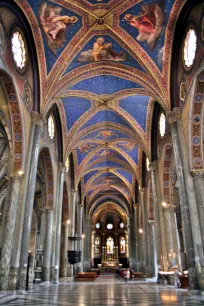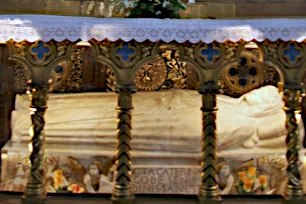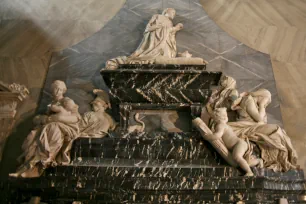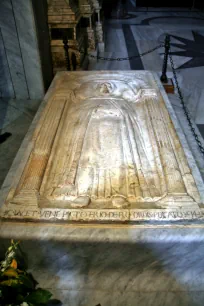The Santa Maria sopra Minerva is the only authentic Gothic church in the Eternal City. Behind the rather plain facade lies a wealth of monuments and tombs, the result of the church’s position as the bastion of the Dominican order in Rome.


The church was built in the thirteenth century on top of the ruins of a Roman temple built by Pompey and dedicated to the goddess Minerva. Hence, the church’s name ‘sopra Minerva’, meaning ‘above Minerva’. It replaced an older church from the eight century.
The church has been renovated and modified many times throughout its history. The Renaissance-style facade dates from 1453 and the chapels were added in the sixteenth and seventeenth centuries. The interior was heavily restored in the nineteenth century in a Neo-Gothic style.
The Dominicans
The design of the church is attributed to Fra Sisto Fiorentino and Fra Ristoro da Campi. These two Dominican friars also designed the Santa Maria Novella church in Florence, which has similar architectural characteristics. The Dominicans were a powerful order which, together with the Jesuits, spearheaded the Counter-reformation. The order was also involved in the notorious Inquisition, which gave them the nickname Domini Canes (Dogs of the Lord). In 1633, they summoned Galileo Galilei to the monastery that adjoined the church of Santa Maria sopra Minerva and forced him to revoke his theorem that the earth revolves around the sun. It took the Catholic Church 359 years to admit they were wrong.
Interior


The church has a cross-shaped floor plan with three naves and a transept. The interior is surprisingly colorful, a result of the nineteenth-century restoration, when marble ornaments were added and the walls and cross vaultings were overpainted.
There are many interesting sights inside the church, including many notable tombs. Catherine of Siena, patron saint of Italy, is buried right below the main altar. At least her body is; her head is in the Basilica of San Domenico in Siena. Catherine was a Dominican nun who, in 1377, convinced the exiled popes in Avignon to return to Rome.


Near the choir is the gravestone of Fra Angelico, a famous Tuscan painter and Dominican friar. He is best known for his work in Florence where many of his masterpieces can be admired in the San Marco Monastery, but he spent his last years in the monastery of Santa Maria sopra Minerva, where he died in 1455.
There are also four popes buried here. Behind the altar are the tombs of the Medici popes Leo X and his cousin Clement VII. The uncrowned Pope Urban VII is also buried here. He died thirteen days after his election as pope, before his official coronation. The tomb of the zealous Pope Paul IV is also in the Santa Maria sopra Minerva. The pope’s role as the driving force behind the Inquisition in Rome made him so unpopular that after his death in 1559 the Romans decapitated his statue on the Campidoglio Square. He was first buried in the St. Peter’s Basilica, but his remains were later transferred to the Carafa Chapel, the most famous chapel in the church.
The chapel was built for cardinal Oliviero Carafa. It is best known for the frescoes created by Filippino Lippi between 1488 and 1492. The central fresco shows the cardinal kneeling while being commended to the Virgin Mary by Thomas of Aquino, an influential Dominican friar. The fresco to the right, opposite the tomb of Pope Paul IV, depicts the “Triumph of Thomas of Aquino over the Heretics”. In the background, you can see the statue of Marcus Aurelius on the Capitoline Hill. The little boys on the architrave supposedly represent two future Medici popes: Leo X and Clement VII.
Another highlight in the church is the Cristo della Minerva, also known as Christ the Redeemer. The great Michelangelo started with the sculpture in 1519, and it was completed in 1521 by his apprentice Raffaelo da Montelupo. The statue was completely nude and shows Christ as if he were a classical hero. The bronze loincloth was added later so that the statue wouldn’t shock the prude and pious.
- Next: Santa Prassede
- More Sights & Attractions in Rome

